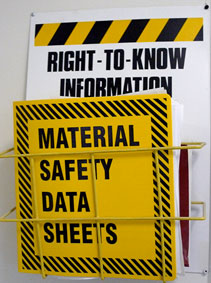
Source: At National Prosthetics and
Orthotics Boston, Nadya Peek, Flickr

Source: At National Prosthetics and
Orthotics Boston, Nadya Peek, Flickr
Proper disposal of laboratory waste is essential in maintaining the health of the environment. Wastes are considered hazardous and non-hazardous. Hazardous materials should only be disposed of in an approved manner. Always follow your teacher's instructions and guidelines for disposal of laboratory wastes. Solid chemicals, metals, matches, filter papers, broken glass, and other materials specified by your teacher need to be disposed of in containers designated for the specific type of wastes. Only use the sink to dispose of water and any solution that your teacher tells you is okay to go down the drain. Do not pour chemicals down the drain.
A Material Safety Data Sheet (MSDS) is a document that contains information on potential hazards (health, fire, reactivity and environmental) and how to work safely with a chemical product. A MSDS also contains information on the use, storage, disposal, and emergency procedures to be followed if a spill or leak of the material occurs. All chemicals in a laboratory should have a MSDS available. Read MSDS information and follow teacher instructions to ensure laboratory material disposal is environmentally sound and safe.

You have been assigned to be the classroom waste management monitor. One part of your job is to keep track of what is thrown away in the classroom. Look at the following items and decide if they can be recycled or disposed of in the trashcan.